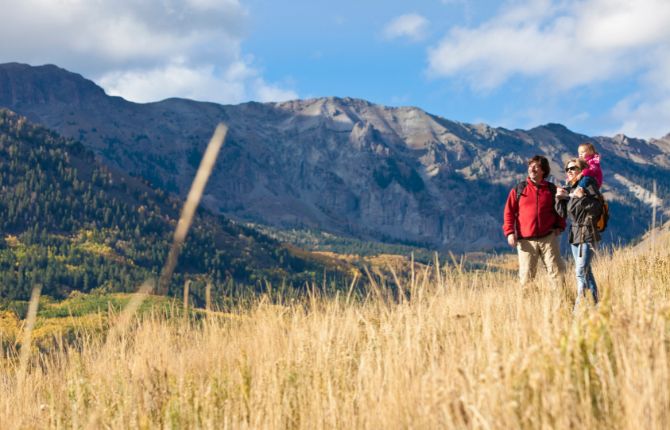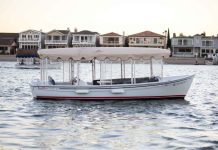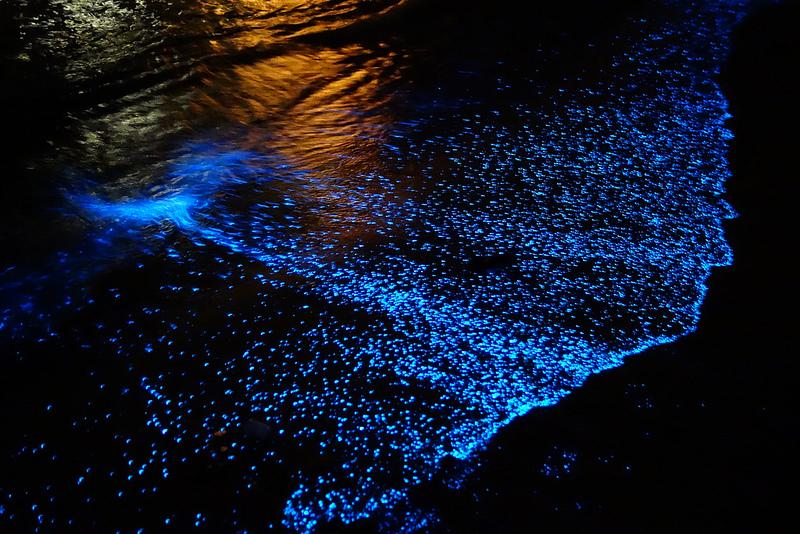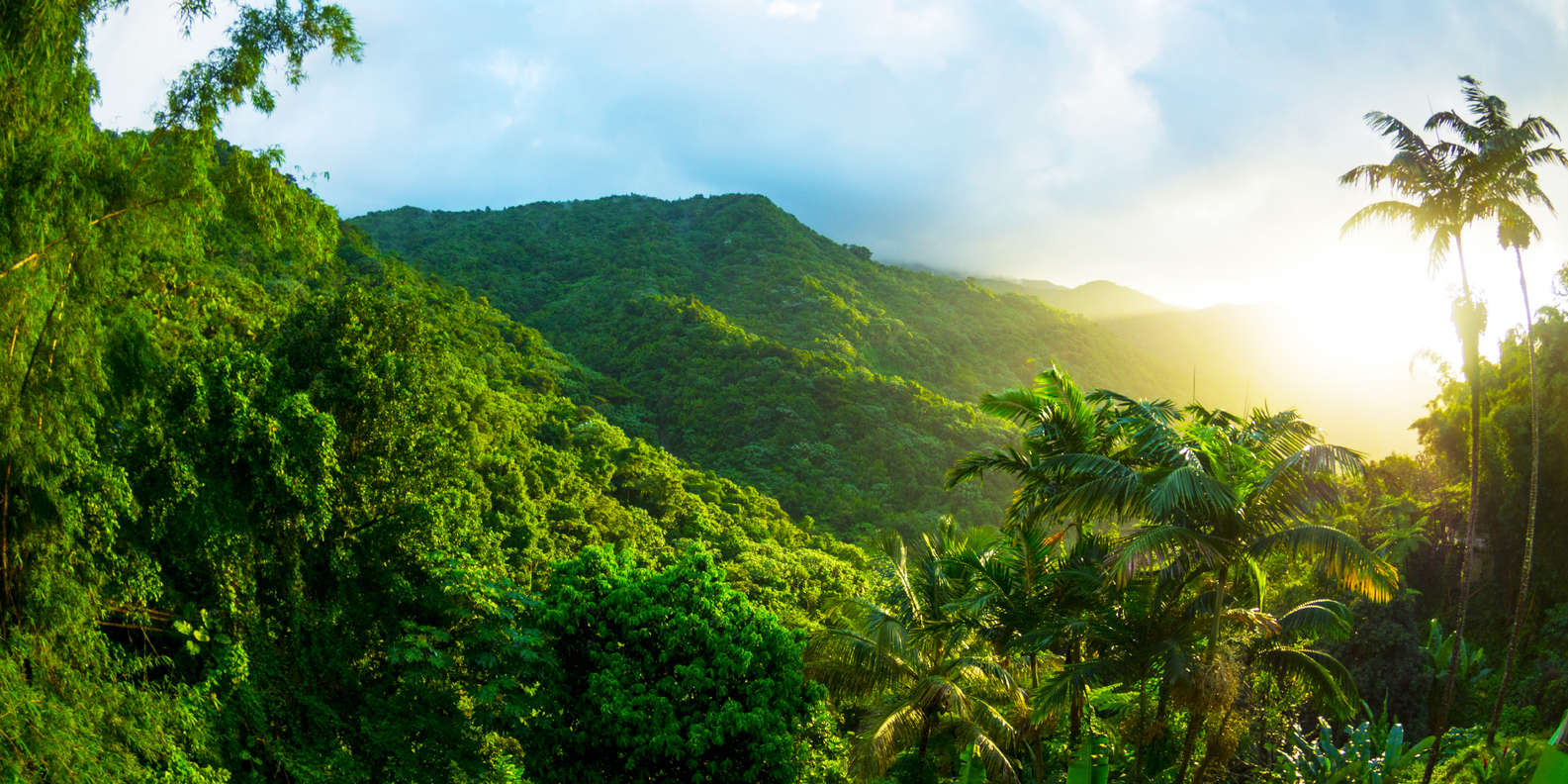Looking for the best things to do in Rocky Mountain National Park in northern Colorado?? This article will help you to make the list and get more important information.
It is the highest national park in the United States. Therefore it is like a paradise for hikers of all levels. Visitors can experience miles of scenic trails, panoramic peaks, diverse wildlife, and many other outdoor recreations.
And also Rocky Mountain National Park features the highest continuous paved road in the United States. Let’s plan your journey to this amazing national park.
1. Things to Do in Rocky Mountain National Park: Trail Ridge Road
One of the most popular activities in Rocky Mountain National Park is driving along the spectacular Trail Ridge Road (elevation up to 12,183 feet)
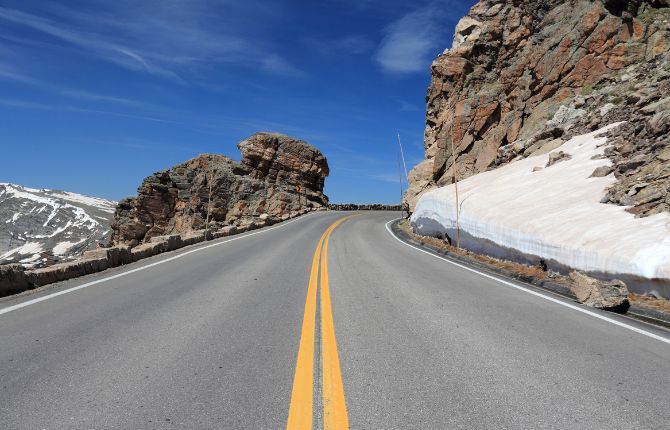
This road offers incredible views of the mountains. Also, you can often see elk and other wildlife along the trail. You can also see bighorn sheep, which are often elusive in this park, but still make for excellent photos.
If you are into hiking, but still need to enjoy the excellent views, surely drive along Trail Ridge Road.
To drive along Trail Ridge Road in Rocky Mountain National Park, you’ll have to take US 36 and US 34 to enter the park. This road marks the eastern terminus of Trail Ridge Road and connects US 36 and US 34.
From here, you can access Upper Beaver Meadows, Bear Lake Road, and Horseshoe Park. After this road, you’ll be in the heart of the park’s mountain scenery, with panoramic views of the Never Summer Mountains.
During your trip to Rocky Mountain National Park, make sure to take the time to hike the scenic trails. You can also stop at the Overlook of Forest Canyon for amazing views.
Once you’ve completed the drive, you can also visit the Alpine Visitor Center for hot chocolate. Just make sure you’re prepared for the altitude! These trails are challenging, so take your time and explore them thoroughly. Enjoy your trip!
But be warned: the road closes during the winter, and may remain closed until early spring, depending on the amount of snow.
Address: Highway 34, Grand Lake, CO 80447, United States Phone: (970) 586-1222
2. Things to Do in Rocky Mountain National Park: Beaver Meadows Visitor Center
If you’re planning to visit the Beaver Meadows Visitor Center in Rocky Mountain National Park, here are some tips.
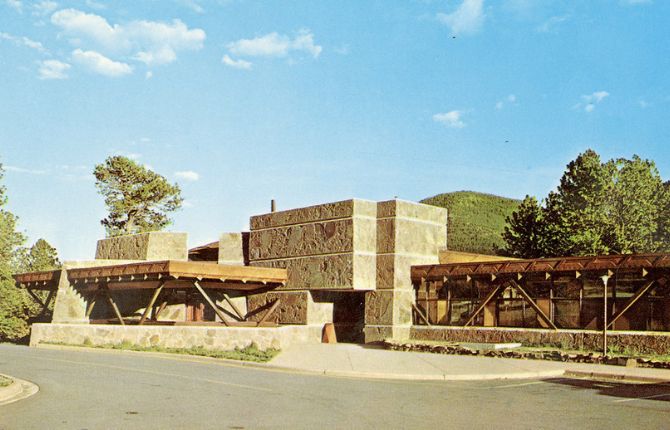
There are three main visitor centers in Rocky Mountain National Park. Beaver Meadows is one of the largest. Open daily, except for Christmas, it has a movie theater and a bookstore.
It also has regular free park films and is the only place on the east side of the park where you can book backcountry campsites. You can also get information on hiking and camping in the park from this visitor center.
The center features short park videos every half-hour, interactive exhibits, park guidebooks, and a Junior Ranger Program.
The Beaver Meadows Visitor Center in Rocky Mountain has information on wildlife and road closures. Visitors can also visit the gift shop. The visitor center is the first stop for most visitors, as it is the closest to Estes Park.
After visiting the visitor center, you can head out on your adventure. You can enjoy views of the park and the surrounding mountains from the observation deck. It is a must-see for anyone visiting Rocky Mountain National Park.
Address: 1000 US-36, Estes Park, CO 80517, United States
3. Things to Do in Rocky Mountain National Park: Downtown Estes Park
There are plenty of free activities to enjoy in downtown Estes Park, Colorado. From jazz concerts to cowboy sing-a-longs, to strolls along the Riverwalk and wine tastings, the town is a great place to spend the day.
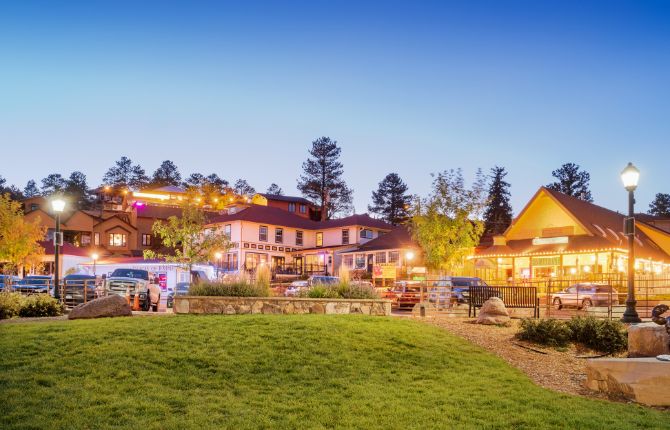
Snow-capped mountains and abundant wildlife are hallmarks of this four-season destination.
The town of Estes is about seven thousand residents and lies along the Big Thompson River. It is also the base for Rocky Mountain National Park, a 265-square-mile area containing more than 100 mountain peaks.
It is easily accessible from Denver and Loveland, or even from Fort Collins, Colorado. There are many restaurants and entertainment venues throughout town, so you can find a good meal and an enjoyable night.
Make sure to plan ahead for dinner or a show because certain attractions may require advanced reservations.
A visit to the Estes Park Museum is a great way to get a sense of the area’s history. The museum houses over 30,000 artifacts from the area’s history, including the EX Stanley Steamer Runabout, a 1909 car powered by steam.
It also houses a large collection of elk, a local icon. The museum is an important place to visit when visiting Estes Park.
Address: 200 4th St, Estes Park, CO 80517, United States Phone: +1 970-586-6256
4. Bear Lake
The most well-known sight in Rocky Mountain National Park is Bear Lake, a classic destination that is one of the most photographed places in the park.
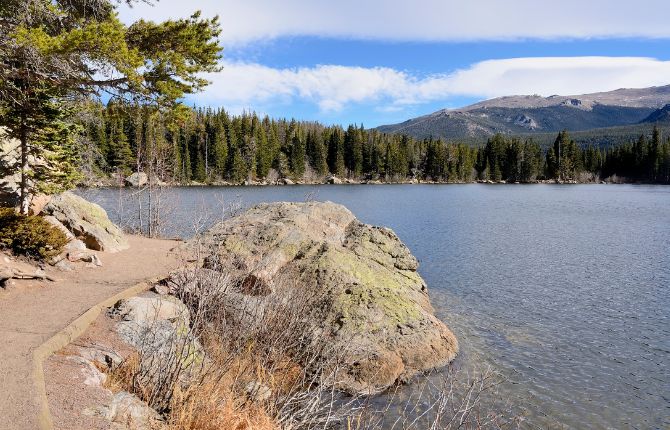
Located beneath the imposing Hallett Peak and the Continental Divide, Bear Lake offers breathtaking views of the mountains and lake.
There are plenty of hiking trails to choose from, including shorter, flatter trails and ones that take you right around the lake. While the park is open year-round, Bear Lake is often less crowded during the winter months.
Visitors can enjoy a scenic 0.8-mile loop trail around the lake. Interpretive signs provide geological and historical information. This trail is popular as a launching point for multi-day backpacking trips.
Other hikes around Bear Lake include a hike to nearby lakes. While hiking to the lake, keep in mind that black bears and grizzlies were present when the lake was named.
To preserve the ecosystem, swimming is prohibited.
Another popular hiking trail is the Bear Lake Hike. This trail is about 3.5 miles round trip and gains 650 feet in elevation. The hike features views of Flattop Mountain and surrounding peaks.
The trail starts a few hundred feet from the parking lot and is accessible by car or public shuttle. During winter, it’s an excellent snowshoe trail.
Whether you’re hiking with your kids or exploring nature with your family, you’ll be in for a treat!
Address: Bear Lake Rd., Estes Park, CO 80517, United States Phone: (970) 586-1206
5. Emerald Lake Trail
If you have been to Rocky Mountain National Park, you’ve probably heard about the Emerald Lake Trail (a moderate hike). It features several breathtaking vantage points, three beautiful lakes, and stunning nature views.
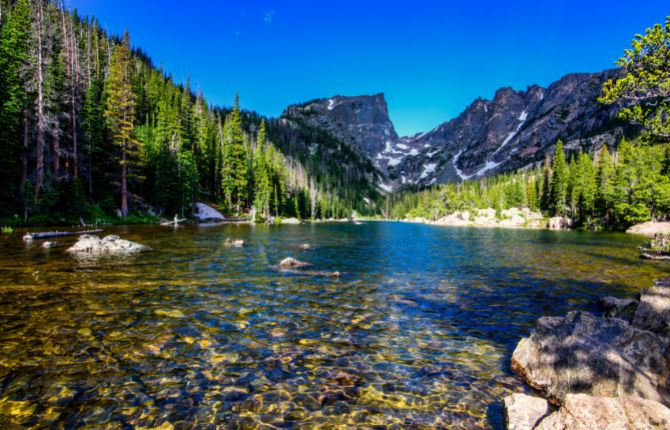
This beautiful hike takes you through a high mountain environment, which is prone to lightning strikes. To avoid this danger, be sure to arrive at the trailhead at least four hours before sunrise.
If you’re planning to hike the trail in midsummer, you should try to start at that time. To avoid the crowds, plan to hike in the morning and back out into the pine forests by mid-afternoon.
Starting from the Bear Lake Trailhead, you’ll soon be hiking in the direction of Emerald Lake. From there, you’ll pass through ponderosa pine forests and aspen groves as you pass by Nymph Lake.
Then, you’ll turn left, looping around the north shore of Dream Lake, which is known for its pond lilies. Along the way, you’ll get great views of the lake and the surrounding mountains.
The Emerald Lake Trail ends at the pristine lake that is surrounded by breathtaking peaks. The trail is approximately two miles long and gains 350 feet in elevation.
The lake’s water is fed by Tyndall Glacier, which is the last glacier in Rocky Mountain National Park.
As such, you’ll be treated to some breathtaking views of Flattop Mountain, Glacier Gorge, and Hallett Peak, which are all visible from this trail.
Address: Bear Lake Rd., Estes Park, CO 80517, United States
6. Moraine Park Museum and Amphitheater
Located in the park’s southern region, the Moraine Camp Museum and Amphitheater are unique venues for learning about the natural world.
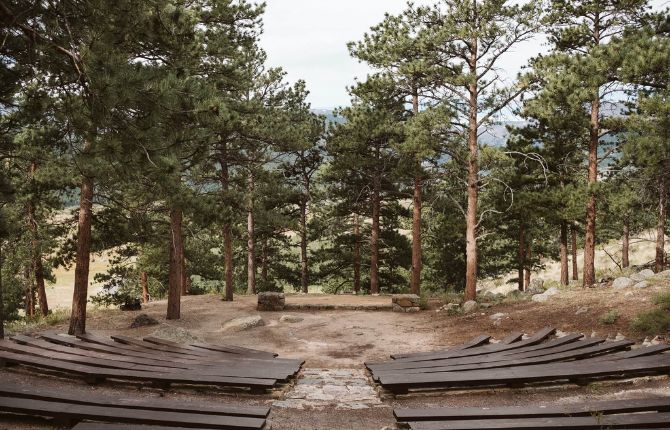
Located in a converted log cabin that was built in the early 1900s, the museum contains natural exhibits and a beautiful outdoor amphitheater that showcases the park’s wildlife.
Visitors can experience a breathtaking view of the mountains and valleys from the museum, as well as learn about the park’s wildlife.
The museum was originally built in 1923 as a lodge, which the National parks service acquired in 1931. The building was demolished in the following years, but a new facility, known today as the Moraine Park Museum and Amphitheater, was built in its place.
It was designed by the National Park Service’s Branch of Plans and Designs and constructed by the Civilian Conservation Corps in 1935. The museum was remodeled during the 1930s and resembles the rustic style of the period.
The building itself is a historic landmark. When purchased by the National Park Service, the Civilian Conservation Corps tore down most of the buildings on the property. In the process, they also constructed the existing amphitheater and improved the parking lot.
Its scenic amphitheater is perfect for weddings, and other events.
The park’s naturalistic architecture was built using the labor of CCC members during the Great Depression. It is now a National Historic Landmark.
Address: 985-1579 Bear Lake Rd, Estes Park, CO 80517, United States
7. Old Fall River Road
If you love the outdoors, Old Fall River Road in Rocky Mountain National Park is a must-drive for nature lovers.
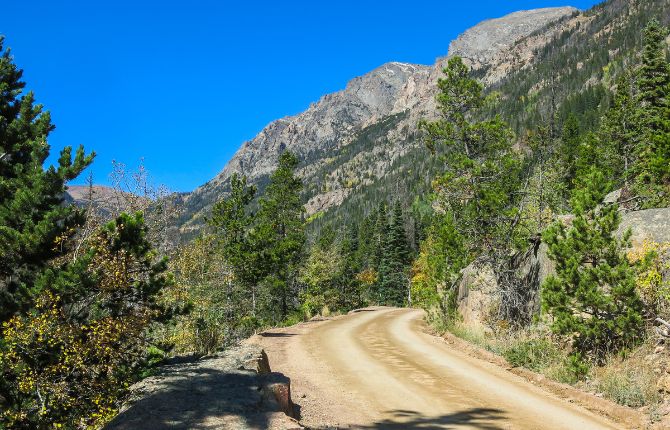
This road was the first automobile route in the park, and it hasn’t changed much in the past 102 years.
Old Fall River Road is open to vehicles from July to October. In winter, it is closed to vehicle traffic but is open for cross-country skiing and snowshoeing.
Pedestrians, leashed pets, and bicyclists may still use the road throughout the park. For more information on Old Fall River Road, pick up a park guide for $1 at the Visitor Center.
While the road is closed to vehicles during winter, pedestrians and cyclists can still take advantage of its beauty.
Several scenic overlooks are located along the road, making it easy to stop for a picture or a rest.
For those who prefer to stay closer to the trailheads, the end valley picnic area is located 1.7 miles from the Fall River Entrance Station. From here, follow the Old Fall River Road for 0.7 miles and reach Chasm Falls.
You can also access the trailhead by car. After a scenic drive along the Old Fall River Road, be sure to visit the nearby waterfalls. The views are spectacular.
When visiting Rocky Mountain National Park, consider using the western entrance. The western entrance is usually less crowded than the east side.
More than 80 percent of visitors enter the park through the east. You will save money by driving through the park instead of using public transportation.
But if you want to save money, the America the Beautiful National Park and Federal Recreational Lands Pass is the way to go. This pass is valid for all of the national parks and many of its national monuments.
Address: Highway 34, Rocky Mountain National Park, CO 80517, United States Phone: (970) 586-1206
8. Holzwarth Historic Site
If you love historical sites and want to see what life was like for pioneers in the late 1800s, you can visit the Holzwarth Historic Site.
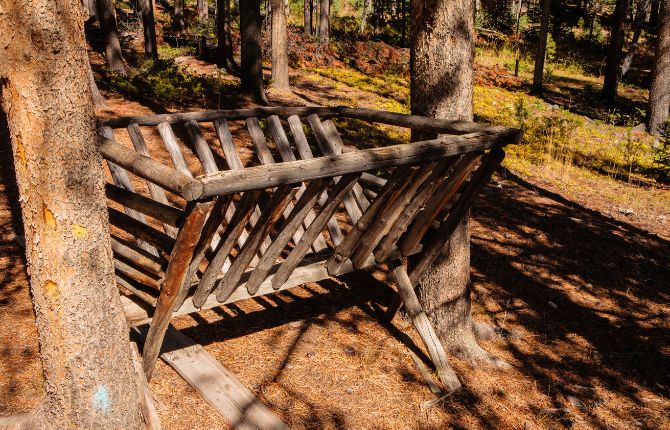
Located on Trail Ridge Road in Rocky Mountain National Park, it’s a short detour from the main park road. You can visit this historic site for free with your park admission.
Holzwarth Historic Site is located in the mountains near the Colorado River, which provides water for millions of people throughout the southwest. Although the park is part of this vast landscape, only a small part of the river flows through it.
During the creation of Rocky Mountain National Park, the ranch became a popular tourist destination. There, you can enjoy activities such as horseback riding, fishing, and home-cooked meals.
Though pets aren’t allowed on the grounds, they’re welcome on leashed leashes in the campgrounds and parking lots.
The Holzwarth family developed the Never Summer Ranch on the east side of the Colorado River. It was a successful dude ranch, hosting visitors from Denver and other nearby areas.
The ranch was named for the Never Summer Mountains, which are known by the Arapaho people as Ni-chebe-chii, which means ‘never-summer.’ In the 1800s, the park was referred to as the Rabbit Ear Range.
Address: US Route 34, Grand Lake, CO 80447, United States Phone: (970) 586-1206
9. Alberta Falls
A 30-foot waterfall, Alberta Falls in Rocky Mountain National Park is a must-see. The waterfall thunders down the small gorge of Glacier Creek, named for one of the earliest settlers of Estes Park, Colorado.
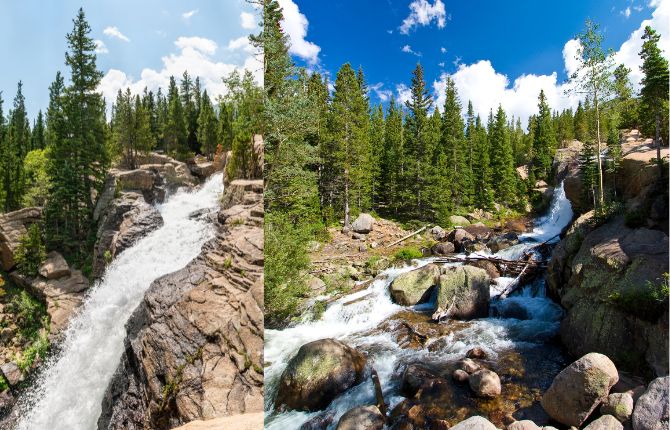
A great hiking trail to Alberta Falls starts by hiking downhill and ends by climbing uphill. The trail offers plenty of shade and is relatively flat. It is a short but scenic hike.
It passes a pine and aspen grove, and several overlooks. The trail is not difficult and is accessible to hikers of all levels. You can enjoy this hike year-round thanks to the many signs that lead to the trailhead.
Hiking enthusiasts can explore the park on foot or on a horseback. Although the trail itself is easy to navigate, the scenery on the mountain is spectacular. Hikers can explore the gorge’s lakes and waterfalls along the way.
Alberta Falls offers an easy-going hike, and it’s well worth the time. While the waterfalls are spectacular, you can also enjoy the view of the Glacier Gorge from a nearby lake.
Autumn is a beautiful time to visit this park when the number of tourists is much smaller. The park is covered in a blanket of fall-colored leaves and is especially peaceful and tranquil.
You can stay at the Spirit Lake Lodge in the park to experience the park’s charms. You can also check out nearby lodgings at Spirit Lake Lodge, where you can enjoy the views while sipping your favorite beverage. The lodge offers a cozy stay for hiking enthusiasts amid nature.
Address: Alberta Falls, Estes Park, CO 80517, United States
10. Sky Pond
Hikers who wish to see a spectacular natural setting will definitely enjoy the hike to Sky Pond in Rocky Mountain National Park.
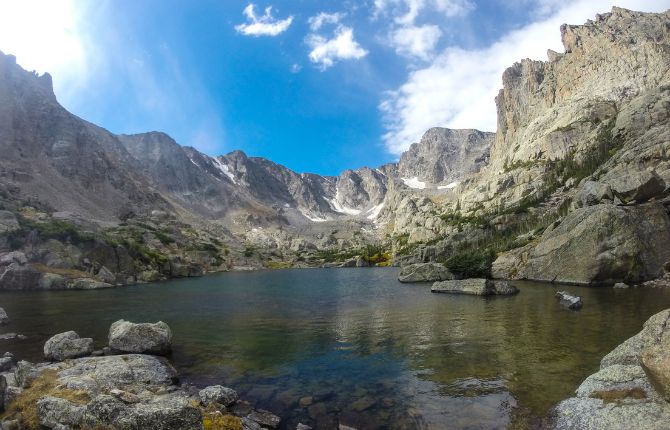
The hike, which starts at Glacier Gorge, passes by three waterfalls and a beautiful set of cascades. Once they reach the top, they’ll be rewarded with a view of this beautiful lake. Getting to Sky Pond is no easy feat, but it’s definitely worth it.
You should wear sturdy hiking shoes with good support. Also, you should pack a raincoat or fleece jacket since temperatures can drop below freezing in the mountains.
While hiking to Sky Pond in Rocky Mountain National Park, you’ll also find breathtaking views of the surrounding region, mountain peaks, a small waterfall, and colorful wildflowers. It’s not easy, though.
The hike to Sky Pond in Rocky Mountain National Park is 9.5 miles round-trip and has a high degree of difficulty. So, be sure to pack plenty of water and food to keep yourself hydrated during the long hike. After all, it’s one of the toughest hikes in the area.
To avoid catching a cold, consider starting your hike early. And don’t forget to pack plenty of water and portable snacks! Because this hike is so popular, make sure to arrive early to avoid crowds. Once you’ve parked your car, begin your hike toward Sky Pond.
When you’re done, you can continue your trek down the Storm Pass trail, which is half a mile long and has a low elevation gain. The hike features stunning views of the Flat Top mountain and the Glacier Basin forests.
During fall, the area is breathtaking. The Storm Pass trailhead is accessible from both Storm Pass and Deer Mountain, and the views from the top are well worth the effort.
Address: Bear Lake Rd, Estes Park, CO 80517, United States
11. Longs Peak
For a great hike through the park, visit Longs Peak, Colorado. A hike of this length is well worth the time, and the reward is the view of Longs Peak from the top of the mountain.
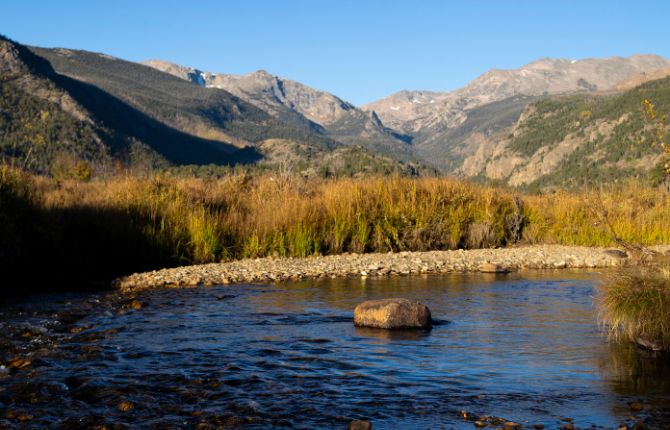
A trailhead for Longs Peak is located on CO-7, just a few miles from the trailhead. A backcountry permit is required, and it is best to request one at least 30 days in advance.
Before hiking Longs Peak, check the park’s website to make sure the weather is good. The website starts updating in May, and conditions usually change between June and mid-July.
Expect a wide range of weather on your hike, with sunny and cloudy days, snowfall, and even thunderstorms. Check the weather forecast and make sure you dress accordingly. You’ll need to bring along an appropriate amount of clothing and a good hiking pole or two, and a hat.
Once you’ve chosen a pair of hiking shoes, you’re ready to tackle the trail.
If you’re planning on climbing Longs Peak, you should consider the Chasm Lake trail. It begins by ascending the Goblin’s Forest and then crosses a series of small streams. Then, you’ll emerge from the forest into an open tundra, with jagged boulders and rock walls that glow in the sunlight.
The trail also offers views of Longs Peak and Lady Washington, the park’s 18-acre granite face.
The Alberta Falls trail is one of the best hikes in Rocky Mountain National Park. It begins from the Bear Lake Trailhead and consists of a 1.6-mile hike to raging Alberta Falls.
Another great hike in Rocky Mountain National Park is Chasm Falls. A short distance away is the Chasm Falls trail, which is located along the Old Fall River Road, which is the first road built into the park.
12. Saint Catherine’s Chapel on the Rock
The Cathedral of Saint Catherine of Siena, also known as Chapel on the Rock, is a unique and beautiful chapel located on the highest formation in the Rocky Mountains.
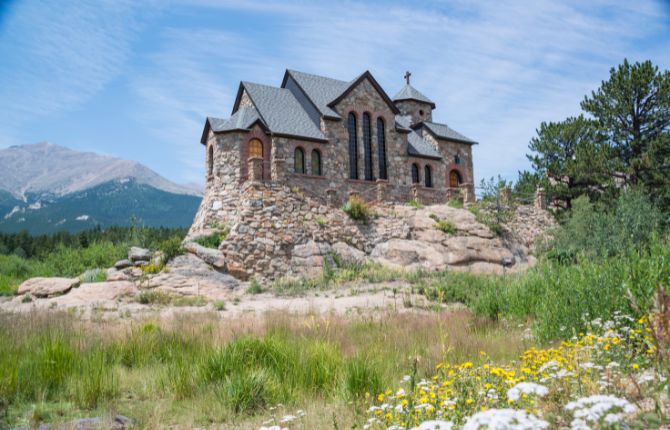
It was blessed by Pope St. John Paul II in 1997 and it is free to enter the public. You are encouraged to bring a donation for its maintenance and restoration.
The Archdiocese of Denver maintains the Chapel on the Rock and is actively involved in its restoration and construction.
The stunning stonework and intricate design of Saint Catherine’s Chapel on the Rock are just a few of the reasons why this place is an iconic landmark of the Rocky Mountains.
Founded in 1929, the chapel is still an active conference and religious retreat center. Visitors can enter and view the chapel during its daily hours of operation. Mass is still held on Wednesdays at noon.
And even though it is surrounded by stunning mountains, this church is a must-see when visiting Rocky Mountain National Park.
The Rocky Mountains are a UNESCO World Heritage Site and are a must-see for every mountain-loving traveler. The surrounding area is also an excellent destination for photographers.
The park is home to numerous wildlife species, and visitors can enjoy hiking trails to view alpine lakes, waterfalls, and steep mountain peaks.
Hikers can enjoy stunning views of the surrounding area on the paved Trail Ridge Road, which is the highest paved road in the park.
Address: 10758 CO-7, Allenspark, CO 80510, United States Phone: (970) 586-5689
13. Cub Lake Trail
A steep, challenging hike awaits hikers on the Cub Lake Trail in Rocky Mountain National Park.
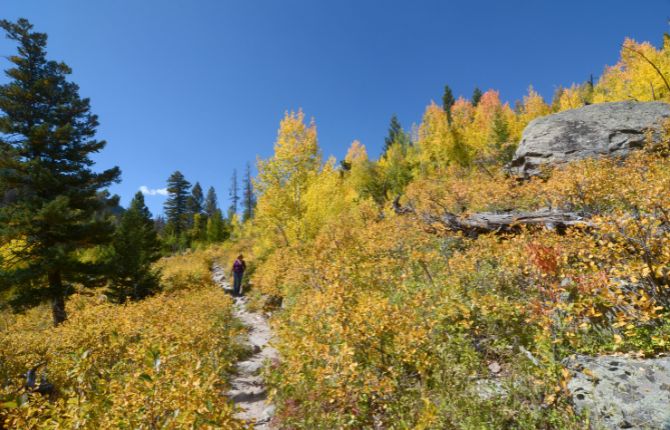
After starting at the trailhead, the Cub Lake Trail starts its descent, which has some of the park’s best views. The trail follows the lakeshore, climbing steeply at times, and descending through a wild area riddled with boulders.
It’s definitely not for the faint of heart, so be sure to bring water and sunscreen.
A 2.5-mile hike to Cub Lake takes hikers through the Moraine Valley, where the Big Thompson river winds through the mountains.
This area is a hive of wildlife, and hikers may run into a Cooper’s Hawk, a rabbit, a marmot, a mommy moose, and a baby moose. Big buck elk and several female companions were also seen on the trail. In summer, the trail is dotted with lily pads.
The trail begins at the Cub Lake trailhead, where you’ll cross the Big Thompson River. After the river, the trail gently undulates along the western edge of Moraine Park.
There is a good chance that you’ll see elk along the trail, and you’ll likely hear a variety of birds along the way. The trail ends in an open area that borders the lake. You can also catch a shuttle service from the trailhead.
Once you’re done with the trail, you’ll see Fern Falls. The cascading waterfall is nearly as impressive as Alberta Falls. Located near Fern Lake, Fern Falls is surrounded by rocky mountains and can be seen on the way back to Fern Lake and Cub Lake.
You can also stop to take a photo of the cascading waters of the lake. It is worth the effort! And don’t forget your camera!
14. Lily Lake
After visiting the Rocky Mountains in the winter, I was eager to get back outside in the sunshine for a visit to Lily Lake in Rocky Mountain National Park.
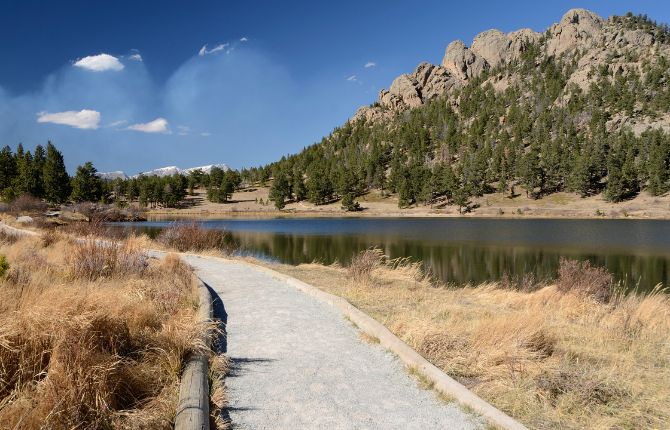
I had never seen such a gorgeous lake! The hike to Lily Lake is short enough for the whole family, and it is accessible just off the highway. Here are some tips to make your trip to Lily Lake a memorable experience:
The Lily Lake Trail is a mile-long, flat trail that circles the lake. This trail is a favorite spot of the “father of the national park” Enos Mills, who often walked here from his cabin.
The trail is a good spot to enjoy the spring wildflowers and wildlife. If you are looking for a quiet, relaxing spot to observe wildlife, Lily Lake is a great choice.
You can hike around Lily Lake from two sides of the lake. You can walk around the lake itself or take the trail around the wetlands nearby. This trail is level and easy to follow and is 6.3 miles from Estes Park.
To get there, you’ll need to take Colorado Highway 7 south of Estes Park. Lily Lake is located on the eastern side of the park.
The parking lot is on the east side of the highway, and there are bathrooms and interpretive kiosks at the trailhead. There are also picnic tables throughout the lake.
Hiking around the area is a great way to explore the park. The 0.8-mile Lily Lake Trail begins at the parking lot. It’s wide and gravel and one of the four handicapped trails in Rocky Mountain National Park is here.
It’s accessible for strollers and wheelchairs and features picnic tables and a fishing pier. The trail is ADA-compliant and wheelchair and stroller-friendly. Dogs are not permitted on the trail, so keep them at home.
Address: South Saint Vrain Ave/Hwy 7, Rocky Mountain National Park, CO 80517, United States Phone: (970) 586-1206
15. Alpine Visitor Center
You can spend a day or even an entire weekend exploring the Rocky Mountain National Park. Whether you choose to hike the trails in the park, or just enjoy the scenery, you’ll be pleased with what you see.
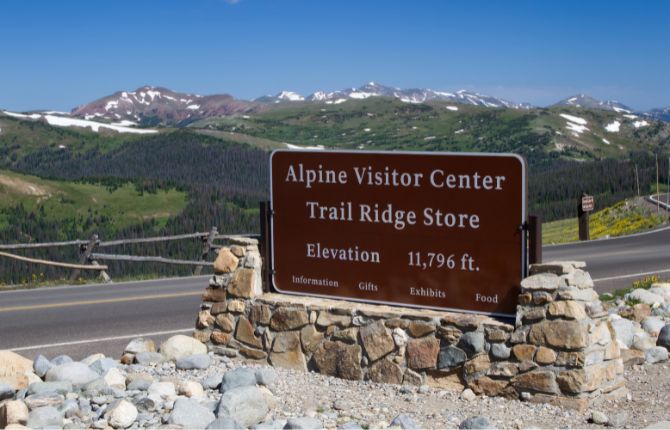
A visit to the Alpine Visitor Center offers several ways to learn about the different ecosystems found within the park.
Visitors can also check out the exhibits at the visitor center and visit dioramas to get a better idea of how the park works.
The Alpine Visitor Center is the highest facility in the National Park System and sits nearly 12,000 feet above sea level. During the winter months, the center closes, but it reopens in late May and early October.
The Alpine Visitor Center offers breathtaking views of the alpine tundra and is also home to a gift shop and bookstore. It has a café and a gift shop.
Another popular area in the park is Bear Lake Trailhead. From here, hikers can access several moderate hikes to lakes nearby. One favorite trail leads to Emerald Lake, which is 3.5 miles round-trip and passes through the Tyndall Gorge. A few other trails begin in this area, so you can choose the best ones for your needs and interests. It’s the perfect place to start a hiking trip in Rocky Mountain National Park!
Address: Trail Ridge Rd., Grand Lake, CO 80447, United States Phone: (970) 586-1222
16. Mills Lake
From the Lily Lake Trailhead, you can begin the trail to Mills Lake. The trail starts with steep switchbacks and ends at the lake.
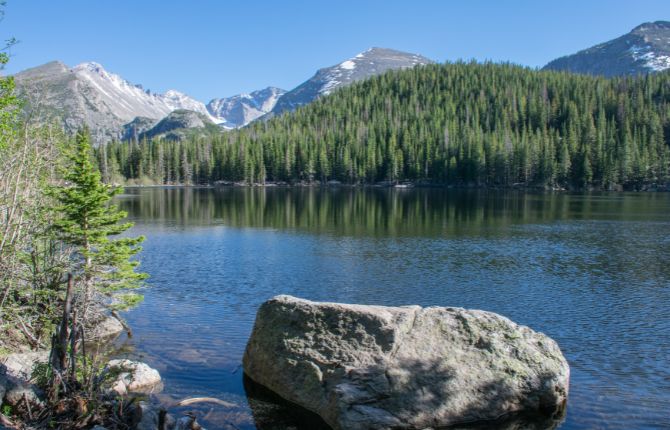
It’s also one of the most popular hikes in Rocky Mountain National Park. Take breaks at Lily Lake to admire the birds, and do not forget to check out the scenic views.
While you’re hiking the Mills Lake Trail, make sure to take breaks to enjoy the lake and wildlife. It’s also a popular hiking trail and is well-marked.
If you’re looking for a longer hike, you can head to Jewel Lake, which is 0.4 miles from Mills Lake. From there, you can hike to the large rock on the lake’s upper end. This is a great spot for a picnic.
Another popular hike is the Sky Pond Trail. This 9.5-mile round-trip hike leads to Timberline Falls, Lake of Glass, and a challenging rock scramble. It takes around five hours to complete this hike.
While visiting Rocky Mountain National Park, you should avoid feeding wild animals. If you do, you’ll risk attracting them and causing them to become dependent on your food.
17. Sprague Lake
There are many things to do near Sprague Lake in Rocky Mountain National. Most of the lake is frozen during the winter, but during the summer, the water can be very inviting for wildlife and fly fishermen.
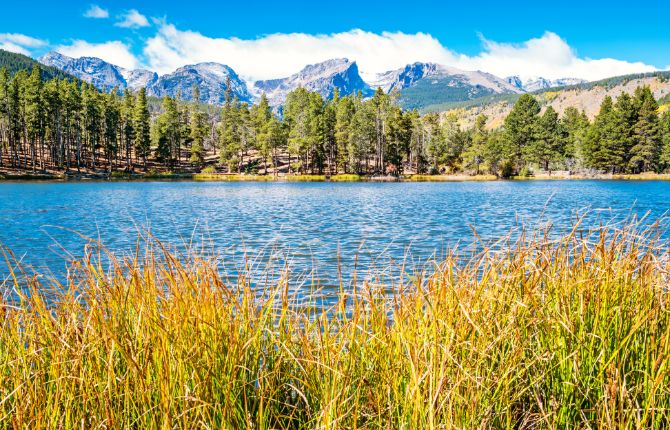
Sprague Lake is one of the best places to watch the sunrise in Rocky Mountain National Park. It is known for its calm waters, which make for beautiful reflection photographs.
If you’re hiking with children, you’ll be pleasantly surprised by all the wildlife you’ll spot during your hike. The lake is also a popular spot for trout fishing. And it’s also a good place to spot wildlife in the early morning hours, so bring a camera!
Sprague Lake is a favorite picnic and nature walk destination in Rocky Mountain National Park. This lake features a level shoreline and is accessible for families. The stocked lake also has rainbow and brown trout.
It is a great place to take children and is often recommended for families. The lake has several hiking trails that are easy to access and are well-groomed for families. There are several campgrounds in the park and reservations are required.
The trailhead for Sprague Lake is located on the east side of the park’s main loop, just off Highway 36. During the peak tourist season, there are free park shuttles to help you reach the lake.
From there, you can reach the Twin Sisters and Flattop Mountain, which towers over the lake. The loop is just under a mile long and relatively flat.
However, you can continue to Lily Mountain, which offers a fantastic view of Estes Valley and the Twin Sisters. However, you should be aware that Lily Mountain requires a thousand feet of elevation gain in the final mile.
Address: Sprague Lake, Estes Park, Co 80517, United States Phone: (970) 586-1242
18. Ouzel Falls
For a great waterfall hike in the mountains, head to Ouzel Falls in Rocky Mountain National Park.
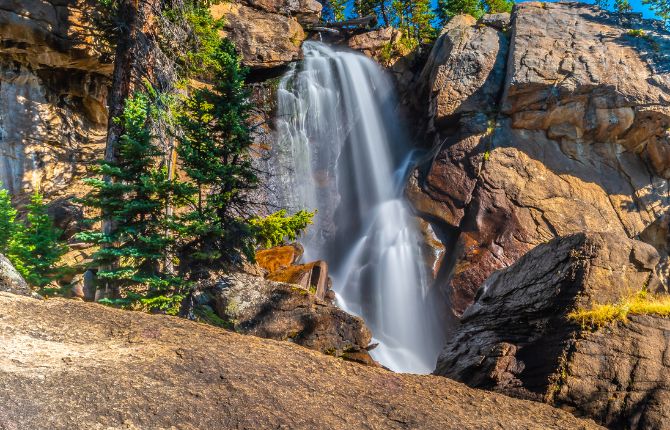
If you’re looking for a relaxing hike, consider Ouzel Falls in Rocky Mountain National Park. This 5.0-mile hike will take you through pine and aspen forests, as well as past three other cascade waterfalls.
The hike begins at the Wild Basin Trailhead, and you’ll soon find yourself walking on the well-marked trail alongside North Saint Vrain Creek. The trail also offers views of the park’s ridges.
The 40-foot drop is both tranquil and awe-inspiring. Wildlife flock to the misty falls in search of cool respite. You’ll need to be prepared for the rushing water though since the bridge over the falls was washed out by a flood in 2013.
A 2.7-mile hike from the trailhead will get you to Ouzel Falls. The trail is beaten-in, so be sure to start early so you won’t have to deal with too many people. If you do arrive late, you might have trouble finding a parking spot.
To avoid the crowds, get there early or make a reservation for a car. The hike is well worth the extra time, especially if you’re bringing your dog!
A moderate trail leads to Ouzel Falls in Rocky Mountain National Park. The trail is located on the less-visited southeast side of the park and has many great resting spots.
If you’re hiking the trail in late September, you can enjoy the changing leaves. A scenic overlook of the falls can be found at the base of Dream Lake. After taking in the stunning view of Ouzel Falls, be sure to stop for a picnic lunch at one of the many picnic tables.
Address: Wild Basin Road, Allenspark, CO 80510, United States
19. Bierstadt Lake
If you are looking for a challenging hike that features gorgeous scenery, try a trip to Bierstadt Lake in Rocky Mountain National Park.
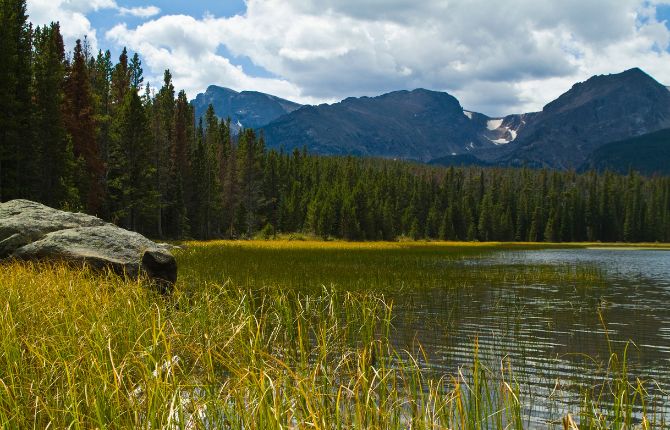
If you’re interested in exploring sub-alpine ecosystems and seeing moose, consider a walk around Bierstadt Lake in Rocky Mountain National Park.
The trail makes a loop around the lake, with varying terrain and demand. Start at Bear Lake Road and hike through a forest of pine trees and firs. Then, take the Bierstadt Lake Loop Trail to the southwest shore of the lake.
Its 3.2-mile loop trail offers breathtaking views of the lake, surrounding snow-capped peaks, and lush forests. The scenic lake is perfect for sunrise or sunset photos and is a popular destination for hikers at any time of year.
Be sure to bring your hiking boots, as the trail is moderately difficult and does involve some uphill walking.
The lateral moraine north of Bear Lake Road is the site of Bierstadt Lake. The lake was formed by a glacier that carved deep canyons and cirques. This movement left behind a thin layer of water called ice.
Bierstadt Lake is named after the famous western landscape painter. His painting was exhibited in the Earl of Dunraven’s Welsh castle. The Denver Public Library owns the painting.
Fishing is a popular activity in Rocky Mountain National Park, particularly during the summer months. However, be sure to check the park’s regulations and possess limits before you go fishing.
Catch-and-release regulations are in place, so remember to release the fish. Those 16 years and older are required to possess a fishing license. You can also try your luck at ice-fishing if you have the equipment.
20. Sombrero Stables
If you’re planning to visit the park, Sombrero Stables in Estes Park is a great option for horseback riding.
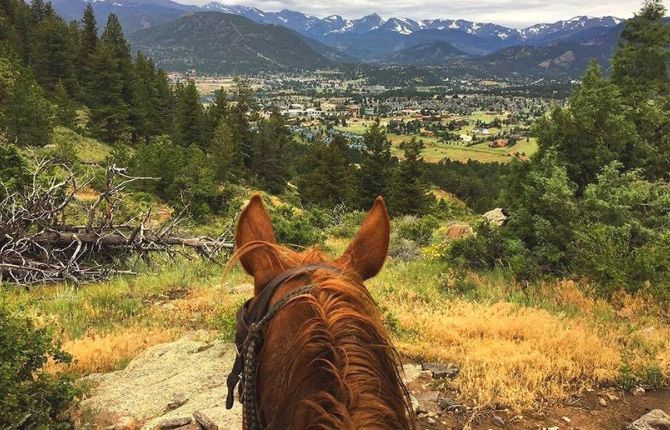
Sombrero Stables is an ideal place to learn how to ride a horse and take part in the Great American Horse Drive. The horses, who live on the ranch, are trained by experienced wranglers, and a lot of miles are practiced before the drive begins.
As a bonus, if you have any reservations for the drive, Sombrero Stables will accommodate your horse-riding needs.
The stables are owned by the Walker family, which owns the largest collection of horses in the country. Riders can choose from 30-minute rides, half-day tours, or two-hour excursions.
Regardless of the length of your ride, you’re sure to enjoy the scenery.
The Walker family spent several years determining which horses would best fit the Sombrero’s frame and rider requirements. The family has over 100 employees, including saddle makers and farriers.
Despite the small stables, it is possible to reserve a ride up to two weeks in advance. Walk-ins are accepted, but reservations are recommended.
For a more adventurous day, consider taking a horseback ride through the park. The park allows pack animals on trails, but you’ll need to limit their number to 20 per string. You’ll also need to feed your animal before a ride.
The SK Horses riding company offers all-day excursions into the park. The ride can take between 30 minutes and two hours.
Address: 1895 Big Thompson Ave, Estes Park, CO 80517, United States Phone: (970) 533-8155
21. Chasm Lake
The hiking trail to Chasm Lake in Rocky Mountain National Park begins in the forest before heading up into the granite cirque.
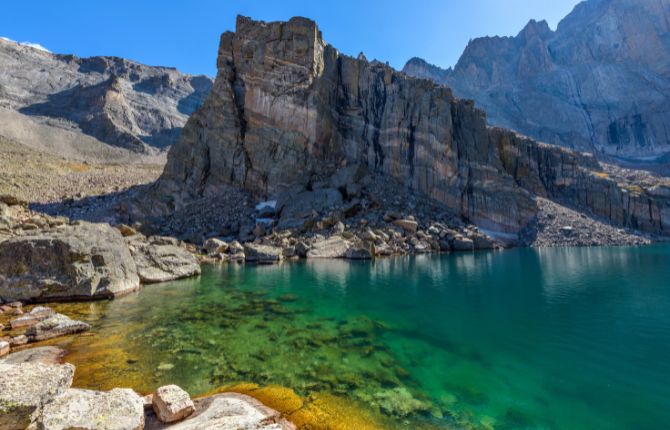
At this point, the views from the trail are breathtaking, with the mountain of Longs Peak in the background. The lake itself is clear and blue, and it’s worth the trip alone.
You can also hike to the lake’s other end, where you’ll be treated to spectacular views.
Hiking through the park to Chasm Lake requires hiking shoes or boots. You may have to cross through the snow to reach the lake, so consider using hiking poles to assist you.
You’ll also need snacks and plenty of water, preferably 3 liters during the summer months. Sunscreen is essential since there is virtually no shade during the day. And don’t forget to take your digital camera – you’ll want to capture the scenery as well as possible.
The Chasm Lake Trail, which spans 8 miles and gains 2,500 feet, is also a popular option. This hike is relatively easy and only requires a two-hour round-trip trip.
The Black Lake Trail combines with the Mills Lake Trail to make for a 10-mile round-trip hike. Beginning at the Glacier Gorge trailhead, you’ll hike for 3 miles before turning around to reach the lake.
Address: Colorado 80510, United States
22. Things to Do in Rocky Mountain National Park: Deer Mountain
If you’ve never hiked Deer Mount, this might be the perfect time to do so. It’s an almost constant uphill climb through a beautiful forest with occasional views of Longs Peak and Moraine Valley.
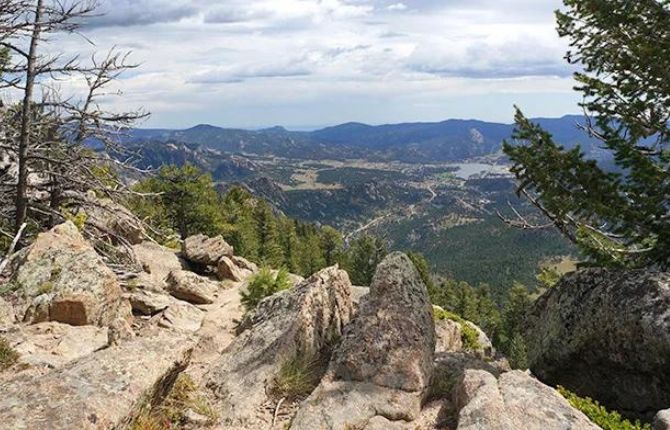
The trail to Deer Mount is a short drive from Beaver Meadows Entrance. It is a moderate hike that climbs 1,400 feet in just over three miles.
While there are some steep sections, the overall pitch is manageable and the view is spectacular. The trail begins as an easy stroll through the meadows and is followed by a gradual climb to the summit.
Once at the summit, you’ll see spectacular views of Rocky Mountain National Park.
The trail to Deer Mount is lower traffic and an easy hike for beginners. It is also a good acclimatization hike for beginners.
If you’re not familiar with hiking in the Rocky Mountains, Deer Mountain is the perfect place to begin. The park’s weather is unpredictable, so be sure to check the forecast before you head out for your hike. If you see thunderstorm clouds building, return to the trailhead.
But the hike is far from exciting and lacks the excitement of other Rocky Mountain hikes. If you’re planning to climb this mountain in winter, bring snowshoes and microspikes.
You may feel like giving the animals some food, but you’ll be rewarded with spectacular views of the surrounding mountains and Moraine Valley.
Address: Deer Ridge Junction, Rocky Mountain National Park, CO 80517, United States
23. Things to Do in Rocky Mountain National Park: Kawuneeche Visitor Center
This scenic visitor center offers information on the local flora and fauna. Hikers can also head out on the short Bear Lake Trail, a 0.6-mile trail that begins and ends at the scenic lake.
There are also accessible fishing docks and benches. Also, there are several campgrounds within the park.
If you’re looking for a place to learn more about the Colorado River, Kawuneeche Visitor Center in the Rocky Mountains is the place to be.
There are several educational programs and a park orientation film, and ranger-led hikes and backpacking trips.
If you’re unsure where to begin, you can always start your adventure from the Kawuneeche Visitor Center, where staff members are ready to assist you.
In addition to a trail map and information on the park, you can purchase backcountry camping permits from the Kawuneeche Visitor Center.
Located about a mile north of Grand Lake, this center is a good place to buy souvenirs. Typical park hours are nine to five. The visitor center is closed on Thanksgiving and Christmas Day, so plan your visit accordingly. You’ll be glad you did!
While the Rocky Mountains National Park is a popular destination, it’s also home to some of the country’s most famous hiking trails. There’s also a campground that offers camping, RV sites, and tent sites.
There are numerous state parks nearby, including Boyd Lake State Park, State Forest State, and St. Vrain State Park.
Rocky Mountain National Park is one of Colorado’s most popular parks and you’ll likely want to visit during the off-season.
During the peak summer months, the park’s roads close, but hiking, biking, and other recreational activities remain available.
Address: 16018 US Highway 34, Rocky Mountain National Park, CO 80447, United States Phone: (970) 627-3471
24. Things to Do in Rocky Mountain National Park: Holzwarth Historic Site
To learn more about the early life of ranchers, visit the Holzwarth Historic Site located in Rocky Mountain National Park.
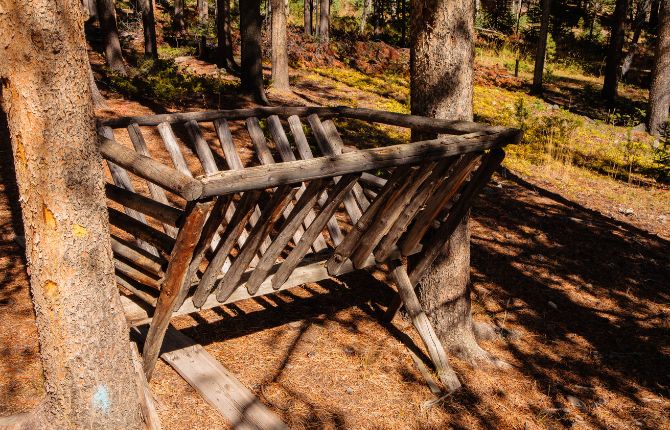
Holzwarth Historic Site, which is home to two log cabins, is situated on the west side of the park. It is easily accessible through a short detour from Trail Ridge Road, located at the western end of the park.
This historic site is a great way to learn about the early history of homesteaders and the culture that accompanied their lifestyle.
This site features hands-on activities and history lessons. Visitors can try on a buffalo coat, wash clothes the old-fashioned way, or rope a steer.
You can also learn about the ranching lifestyle during the early modern era. The Holzwarth Historic Site is located near Timber Creek Campground.
Located in the Kawuneeche Valley, the Holzwarth Historic Site is a great place for families to visit. Visitors are welcomed by members of the Holzwarth family, who will share the history of homesteading and early dude ranching.
It is well-marked with well-written descriptions and full-color photographs of the homestead’s historic structures. The site also features a trail through the Kawuneeche Valley, where deer often graze.
Address: US Route 34, Grand Lake, CO 80447, United States Phone: (970) 586-1206
Things to Do in Rocky Mountain National Park
- Trail Ridge Road
- Beaver Meadows Visitor Center
- Downtown Estes Park
- Bear Lake
- Emerald Lake Trail
- Moraine Park Museum and Amphitheater
- Old Fall River Road
- Holzwarth Historic Site
- Alberta Falls
- Sky Pond
- Longs Peak
- Saint Catherine’s Chapel on the Rock
- Cub Lake Trail
- Lily Lake
- Alpine Visitor Center
- Mills Lake
- Sprague Lake
- Ouzel Falls
- Bierstadt Lake
- Sombrero Stables
- Chasm Lake
- Deer Mountain
- Kawuneeche Visitor Center
- Holzwarth Historic Site


